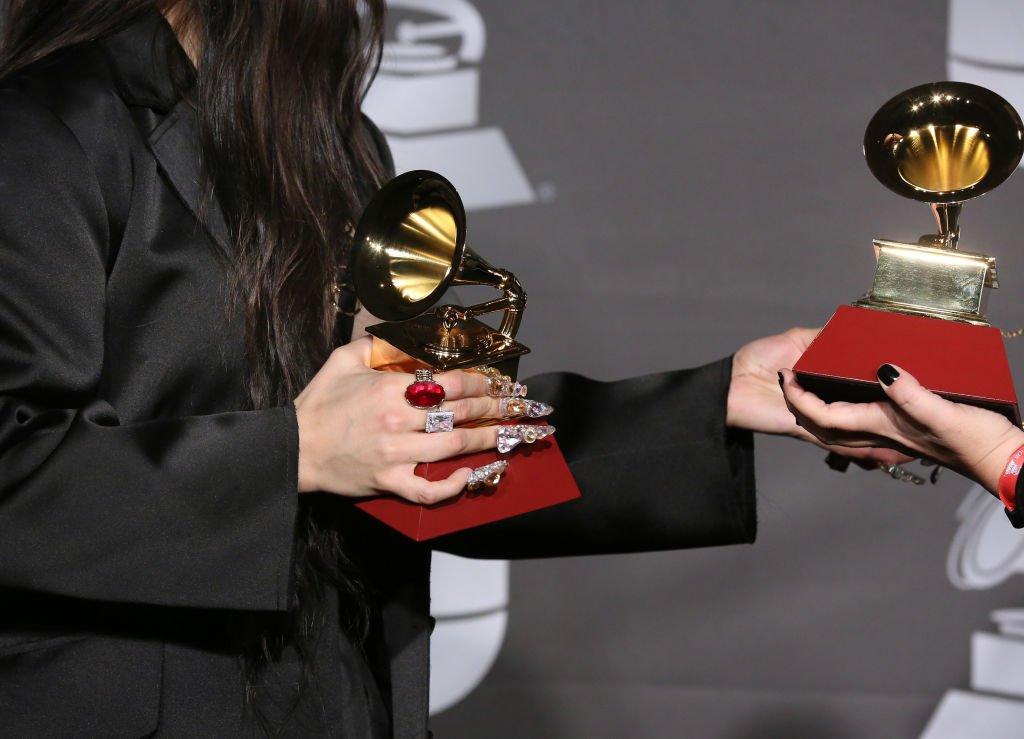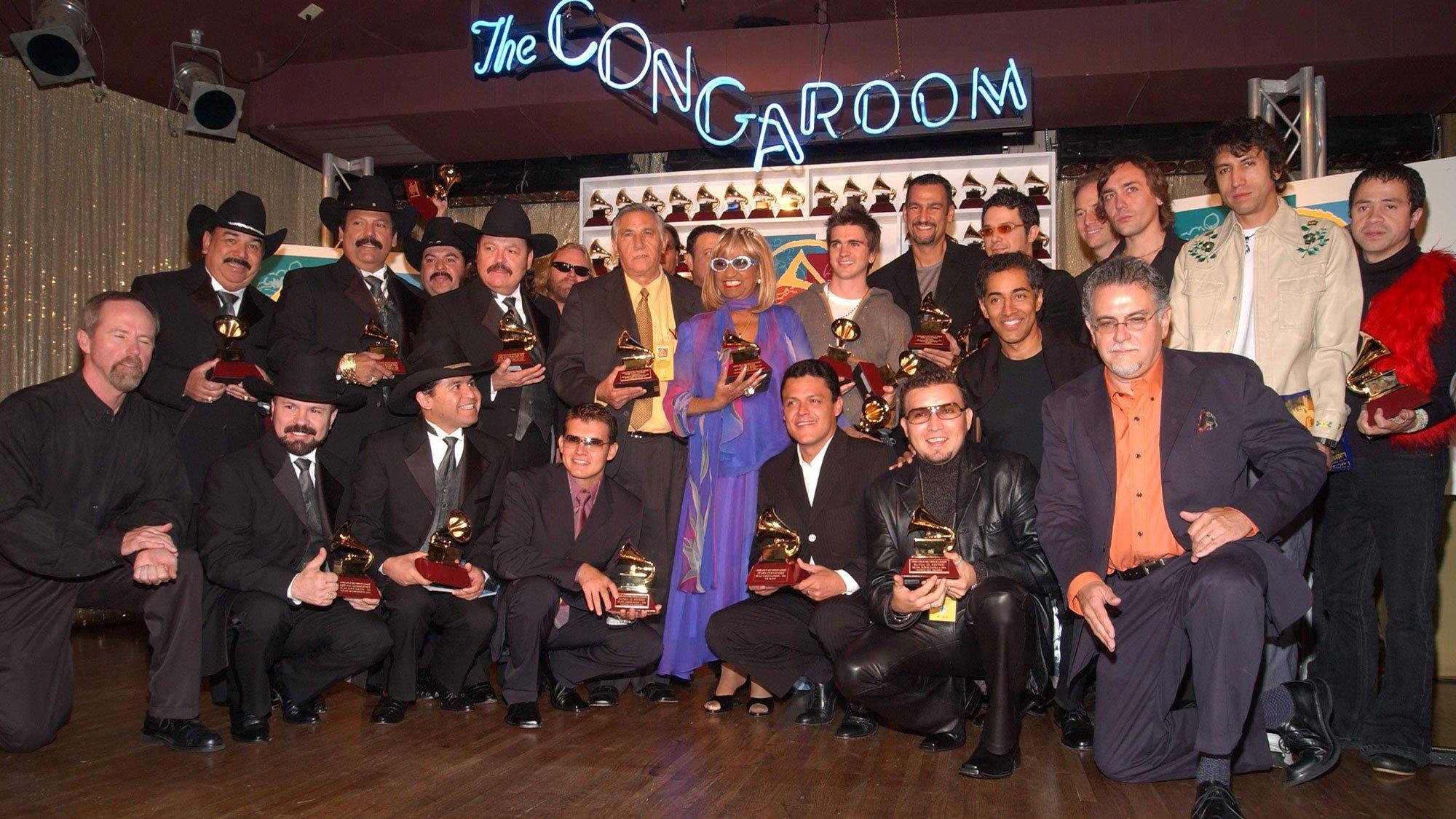Photo: Gabe Ginsberg/Getty Images

Latin GRAMMY Awards
news
Poll: Who Will Voters Choose For Best New Artist At The 2020 Latin GRAMMYs?
Anuel AA, Rauw Alejandro, Mike Bahía, Cazzu, Conociendo Rusia, Soy Emilia, Kurt, Nicki Nicole, Nathy Peluso, Pitizion and Wos are all in the running for 2020 Latin GRAMMY Best New Artist
The nominees for the 21st Latin GRAMMYs have been announced (on Sept. 29), and this year's slate of artists in the running for Best New Artist represent a diverse lineup of talented music creators who have made a breakthrough impact on Latin music this past year.
This year's nominees include Puerto Rican rapper Anuel AA, Puerto Rican singer-songwriter Rauw Alejandro, Colombian singer Mike Bahía, Argentinian rapper Cazzu, Argentinian rock/pop band Conociendo Rusia, Colombian alt-pop Soy Emilia, Mexican pop singer Kurt, Argentinian rapper and singer Nicki Nicole, Argentinian pop singer Nathy Peluso, Colombian singer/songwriter Pitizion and Argentinian rapper Wos.
Who do you think Latin Recording Academy voters will choose to take home the coveted award? Cast your vote below!
Of the 11 nominees for Best New Artist, Anuel AA, Conociendo Rusia and Nathy Peluso are the only up for awards in additional categories—see the full nomination list here.
Last year, at the 20th Latin GRAMMY Awards, Venezuelan artist Nella won Best New Artist.
See who takes home the Best New Artist gramophone and more when the 21st Latin GRAMMY Awards airs live on Univision, Thurs., Nov. 19 at 8:00 p.m. ET/PT (7:00 p.m. CT).

Photo: Courtesy of the Conga Room
news
L.A.’s Historic Conga Room Closes With A Final Party Celebrating Latin Music Excellence
The L.A. Live venue will officially close its doors at the end of March, after two decades of supporting live Latin music (and the Latin GRAMMYs). Ahead of their farewell party, the Conga Room's founder and staff discuss its history and significance.
Los Angeles' legendary Conga Room is closing its doors, but will not go quietly into the night.
The 25-year-old venue has been home to countless Latin music performances and celebrations — including the 2001 Latin GRAMMYs — and will host its final event on March 27. The official, invitation-only closing celebration will feature a performance by Puerto Rican salsa star Gilberto Santa Rosa and the Conga Kids, as well appearances from Jimmy Smits and Paul Rodriguez, both of whom were investors in the space.
First opened in 1999 on Wilshire Boulevard by real estate entrepreneur and Latin music lover Brad Gluckstein, the Conga Room drew investors like Jennifer Lopez and Sheila E — all of whom were committed to the venue’s vision of being an upscale nightclub devoted to live Latin music and dancing. In both its Miracle Mile location and its later space at L.A. Live, the club attracted an absolutely staggering lineup of talent, including Celia Cruz, Buena Vista Social Club, Tito Puente, Carlos Santana, Alejandro Fernández, Fito Paez, Jerry Rivera, Bad Bunny, and Maluma. The venue also hosted performances from non-Latinx artists like Prince, Ed Sheeran, Lenny Kravitz, Kendrick Lamar, Stevie Wonder, Chaka Khan, and Avicii.
"I saw Prince perform in venues the world over, but his very first performance at the Conga Room was magical," says talk show host Tavis Smiley. "Of all the times I witnessed my friend on stage, from Madison Square Garden to Montreux, the Conga Room remains my favorite Prince performance."
Gluckstein says that the Conga Room was able to draw such great talent not just because it was one of the only major venues that leaned into Latin music in the United States, but because there was a mutual respect between the artists and the venue.
"We couldn’t compete financially with [Goldenvoice or AEG], but we were able to bring an incredible amount of talent to the venue," he tells GRAMMY.com. "I was talking to Jerry Rivera’s agent the other day and I said, ‘Jerry just played in front of 10,000 people in Venezuela. Help me understand why playing in front of 1,000 people at the Conga room was so important.’ He went on for 10 minutes about what the room meant to these artists and the way we respected them, the sound system, and the way they were treated. The fan engagement, too, plus the fact that there was never really a comparable room anywhere else, even in New York."
"We provided a stage and a voice for acts that didn’t have a way of getting to their audience here in L.A., because no radio stations were playing their kind of music," says Marcella Cuonzo, the venue’s publicist. "For reggaeton, for example, the Conga Room was a pioneer in the movement around 2010. Radio wasn’t playing that music, but the Conga Room took a gamble on the sound because they saw its vision."
The Conga Room was also the first venue in Los Angeles to host a wide-range of Cuban musical talent starting in the mid- to late ‘90s. "We had probably 50 shows," says Gluckstein. "We got everything from Bebo Valdés to [Diego] El Cigala to Pablo Milanés, who played his first show ever in the U.S. at our venue. He’s the Bob Dylan of Cuba. We brought Los Van Van, who’s probably the most famous salsa or timba group in the history of Cuba. They couldn’t play in Miami, because Miami wouldn’t allow Cuban music, so the GRAMMYs gave them their trophy [for Best Salsa Performance] at the Conga Room."
The Latin GRAMMY Awards moved from L.A. from Miami in 2001, and the ceremony was set to take place at the Shrine Auditorium on Sept. 11. That telecast was understandably canceled following the tragic events of that day in New York, and rather than rescheduling the whole event, winners were announced at a press conference on Oct. 30 at the Conga Room. Alejandro Sanz came away with four awards, including Album Of The Year, and Juanes took home three Latin GRAMMYs, including Best New Artist.
"I remember Celia Cruz giving a beautiful speech that night in Spanish, thanking the firefighters and policemen and saying ‘this is for you, but also a little bit for us," says Gluckstein. "In later years, once we were at L.A. Live, we hosted the Latin GRAMMY nominations several times. I have footage of Andy Garcia doing them on-stage with Jimmy Smits."
The Conga Room is closing now because, Gluckstein says, it just seems like the right time. "The pandemic, of course, played a role," he explains. "And I think the enormity of AEG and Live Nation, with how fierce the competition is, all of that has made buying talent much more expensive and has made talent more selective in terms of what's the best economic opportunity for them."
There’s also the rising success of Conga Kids, the venue’s non-profit arm, to consider. A county-wide organization with about 100 employees, Conga Kids reaches roughly 50,000 elementary-aged kids in largely under-resourced communities every year, using dance and music from the Afro-Diaspora like salsa, merengue, cumbia, reggaeton, Charleston, and hip-hop to promote social and emotional well-being, as well as diversity, equity, and inclusivity.
Though fans and artists will undoubtedly miss the space, energy, and community the Conga Room provided, Gluckstein says the venue’s closure doesn’t have to be sad. Instead, he says, it can be celebratory.
"We accomplished so much," he says. "Now, the venue will just have to live on in the hearts and minds of people, instead of as a brick and mortar space."

Photo: 5020 Records
interview
Inside Residente's 'Las Letras Ya No Importan': How His New Album Shows The Rapper In Transition
"It’s an album that marks a musical transition for what’s coming for me," Residente says about his sophomore record, 'Las Letras Ya No Importan.'
Puerto Rican rapper Residente wants to embark on new adventures.
The artist born René Pérez Joglar has dreams of directing movies and acting, writing books, and making for pleasure — not to pay the bills. These goals reflect a new attitude, one resulting from time spent reflecting on the passage of time and the presence of death.
Residente's sophomore album, Las Letras Ya No Importan (Lyrics No Longer Matter), echoes this transitory period. An extensive body of work, featuring 23 tracks, with several songs surpassing the five-minute mark. Las Letras is an act of deeply intimate rebellion.
"It’s a very personal album, and I sought to connect with myself in many moments throughout," Residente tells GRAMMY.com.
While Las Letras explores topics already a hallmark of his music — the music industry, political systems, Puerto Rico — it's also exceedingly vulnerable. The 28-time Latin GRAMMY and four-time GRAMMY winner opens up about depression and personal relationships, and confronts mortality.
Lead single "313" is inspired by Residente's late friend Valentina, whose voice appears in the first interlude. As Residente recounted to El País of Spain and GQ Spain, Valentina was a violist, and the last messages they exchanged on WhatsApp were at 3:13.
The song begins with a French verse, fulfilling Valentina’s wish, expressed in the first interlude, to do something in that language. "Les paroles n'ont pas d'importance," (words no longer matter), a female voice whispers, followed by a spectacular string arrangement.
Residente revisited older works during this period of creative transition, and the record features previously released tracks "René," "This Is America," and "Quiero Ser Baladista."
Las Letras Ya No Importan features many collaborations, with actress Penélope Cruz, Spanish singer Silvia Pérez Cruz, Rauw Alejandro, Ricky Martin, Christian Nodal, Arcángel, Jessie Reyez and others making appearances. Hip-hop icon Busta Rhymes is featured on "Cerebro," while Big Daddy Kane makes an appearance on "Estilo Libre" with Vico C.
GRAMMY.com spoke with Residente via Zoom about the process that led him to his second album, the symbolism behind "313" and the artistic connection to Spain.
This interview has been edited for length and clarity.
What inspired you to create Las Letras Ya No Importan?
It’s an album that marks a musical transition for what’s coming for me. It feels diverse; it also has songs with which I may not feel as connected [to] now because several years have passed since I made them. There are newer songs with which I do connect, which have a bit more to do with the way I want to start working on my music in the future.
"René" is part of this album, even though it came out four years ago. This is an album I was going to release during the pandemic.
We have "René," which is very personal; we have "313," which I also feel is personal; then "Ron en el piso," [a song about the passage] of time, the collaboration with Nodal ("Pólvora de Ayer") also touches on the theme of time, of enjoying everything.
You confront death in several songs. In "René," you sang about losing a friend; in "Ron en el piso," you see your funeral; and in "313," you draw inspiration from your late friend Valentina. What is it about death that inspires you?
It’s something I’ve been going through in recent years. I lost many people I love, and it made me much more reflective when it comes to understanding time, the things I want to do, and the things I’ve stopped doing.
That’s why I’m also transitioning to cinema. I’ve always wanted to make films, directing, being behind the scenes, not being on stage. I’m crazy about dedicating myself entirely to that.
I discovered acting now in a movie I starred in [In the Summers] that won the Jury Award at Sundance. When I saw it, I didn’t know I was the protagonist until I watched it. [The film] encouraged me to follow that too, and I’m going to want to act, direct; I want to dedicate myself to that for a while fully.
The album has a lot of life, and even though the lyrics no longer matter, you still have much to tell. You already said the album is very personal, but how would you describe it?
I can describe it in two years, not right now. It’s transitional. That’s what happened with Calle 13; everything was a musical and lyrical change from the second album onwards.
Residente represented a fusion of world music and rap. Now, in this one, I’m using a lot of strings, cellos, and double bass. I’m going to experiment a lot with different instruments in different ways. I’m going to be creative without the need to balance the album.
What’s coming next doesn’t have that artistic pressure. The only artistic pressure I want to have is to do the highest I can, which happens organically, not feeling pressured but naturally.
I want to do art as I did in college [at Savannah College of Art and Design]. I was never thinking about people or trying to convince anyone, and I was completely free, and that’s what happened with "313." I had the freedom I always wanted to have.
There’s substantial symbolism in "313," from the faceless dancers, the color pink. What was your vision with the visuals?
The dancers represent time. Penélope [Cruz] can represent many things, from life to Valentina, my friend, who inspired me to make the song. Penélope controls me, holds me, flies me, brings me back, and then I decide to control my life and time. That’s why I raise my hands, and everyone raises them, and time is running out, and then you see a sunset.
Sunset marks the end of something. The colors of the costumes also have some dusk elements. You can see at the end when I’m disappearing; it fades and blends with the end of the sunset.
These are decisions I make that are both aesthetic and technical. I put masks on the dancers because I liked it aesthetically. It also helped me speed up the process with makeup. I had to find creative ways to maintain the video’s aesthetics and make everything more agile because in filming, everything is time, and I had little of it.
What’s the idea behind the song "Las Letras Ya No Importan?"The arrangement is magical, with a numerical sequence from one to eight in different languages and a voice spelling of the alphabet.
That was the initial track. Before "313," I had this idea that I dreamed of with some basic notes, and it turned into something big.
There’s a voiceover of Penélope [Cruz] that says that we were eight [people in the studio], we are on an 8th street in New York, in studio B, which, if you look at it, it resembles the number 8. Everything connected with eight and [that number] also at a time level can mark infinity. So, I connected all that with the immensity of letters and languages. That piece’s runtime is five minutes. I think it’s pleasurable. I like that music, which resembles what I want to do.
Leo Genovese, an excellent musician and musical genius, made the arrangements. I greatly respect him.
In "Cerebro," you showcase your skill and vocal speed; what was it like collaborating with Busta Rhymes, whose own flow is iconic?
We met, and he loved the concept of what I was working on. He was a very humble, good person to me. After we met in person and talked for a while, he went to write after I sent him everything I had written in English.
I created ["Cerebro"] a while ago…. That’s why I tell you that the album has several concepts that I had to let go of because it was too much, and a lot of time had passed. I had a previous concept when I released the song "René" [in 2020], which is why it’s on the album. [At that time] I was working with the brain waves of different animals and people, and I made music with those brain waves.
This song ["Cerebro"] is part of that, and that’s why it’s called "Cerebro." The album was originally going to go that route. Then I didn’t do it; maybe I’ll connect to it in the future because I loved that idea.
What has Spain meant to you? The country has been so prominent in the trailers you’ve released and in the collaborations in your latest songs.
I've been making frequent trips to Madrid. This past year, I was there a lot; I was more in Madrid than at home. I traveled, wrote, and filmed videos like "Problema cabrón" and "313."
I grew up with Spanish cinema by Almodovar and a bunch of directors I admire, and I wanted to collaborate with the actors I grew up watching in movies.
This album has many personal elements, and cinema is very intimate for me. I saw [Penelope Cruz] in [the movie] Abre los ojos when I was a kid; working with her now is a dream. The same goes with Javier Cámara and Najwa (Nimri) [who is in the film] Lovers of the Arctic Circle by Julio Medem. I saw all these people, and now being able to collaborate with them, be friends with them, talk to them is a dream. Everything is very connected to my life.
Erick The Architect Steps Into A New World On 'I’ve Never Been Here Before'

Photo: Lester Cohen/Getty Images for The Recording Academy
news
How The Latin GRAMMYs Brought Latin Music Excellence To The 2024 GRAMMYs
Latin music was celebrated throughout GRAMMY Week and on Music's Biggest Night. Read on for the many ways Latin music excellence was showcased at the 204 GRAMMYs.
The 2023 Latin GRAMMYs may have occurred months ago and thousands of miles away, but the leading lights in Latin music also shined at the 66th GRAMMY Awards. From historic wins and meaningful nominations, to electric performances and interesting installations, Latin music excellence was everywhere.
In anticipation of the 25th anniversary of the Latin GRAMMYs in 2024, the exclusive GRAMMY House — the site of multiple GRAMMY Week events — included a significant installation dedicated to the Biggest Night In Latin Music.
The cylindrical display showcased some of the biggest moments in Latin GRAMMY history, including images, facts, and even a real Latin GRAMMY award.
The celebration of Latin music continued throughout GRAMMY Week, with several Latin GRAMMY-winning artists also winning on the GRAMMY stage. Among the major moments at the 2024 GRAMMYs, Karol G won her first golden gramophone for her 2023 LP Mañana Será Bonito. "This is my first time at GRAMMYs, and this is my first time holding my own GRAMMY," the Colombian songstress exclaimed during her acceptance speech.
Música Mexicana star Peso Pluma also took home his first GRAMMY; his album GÉNESIS won in the Best Música Mexicana Album (Including Tejano) Category.
Premiere Ceremony presenter Natalia Lafourcade — whose Todas Las Flores won big at the 2023 Latin GRAMMYs — also took home the GRAMMY Award for Best Latin Rock or Alternative Album. She tied in the Category with Juanes.
Premiere Ceremony performer Gabby Moreno also took home a GRAMMY Award for Best Latin Pop Album for her album X Mí (Vol. 1).
Beyond the stage, Latin artists graced the red carpet and the nominations list. For example, producer and songwriter Edgar Barrera was the only Latino nominated in the Songwriter Of The Year, Non-Classical Category.

Photo: Amy Sussman/Getty Images
news
2024 GRAMMYs: Victoria Monét Wins The GRAMMY For Best New Artist
Victoria Monét beats Gracie Abrams, Fred again.., Ice Spice, Jelly Roll, Coco Jones, Noah Kahan, and The War And Treaty.
Victoria Monét has won Best New Artist at the 66th GRAMMY Awards.
Tearfully accepting the award, the rising R&B star gave an eloquent speech in which she compared herself to a plant growing out of the soil of the music industry.
“My roots have been growing underneath ground, unseen, for so long, and I feel like today I’m sprouting, finally above ground,” she said.
Monét beat out Gracie Abrams, Fred again.., Ice Spice, Jelly Roll, Coco Jones, Noah Kahan, and The War and Treaty for the award. It was given out by last year’s winner, Samara Joy.
She really puts in the work and she is being rewarded now more than ever for it," producer D'Mile, who has known Monét since the beginning of her career, recently told GRAMMY.com. "She grows more and more confident and sure about what she's aiming for as she continues her journey."
This was not Monét’s first win. Her album Jaguar II won Best Engineered Album and Best R&B Album earlier in the day during the GRAMMYs Premiere Ceremony.
Keep checking this space for more updates from Music’s Biggest Night!
